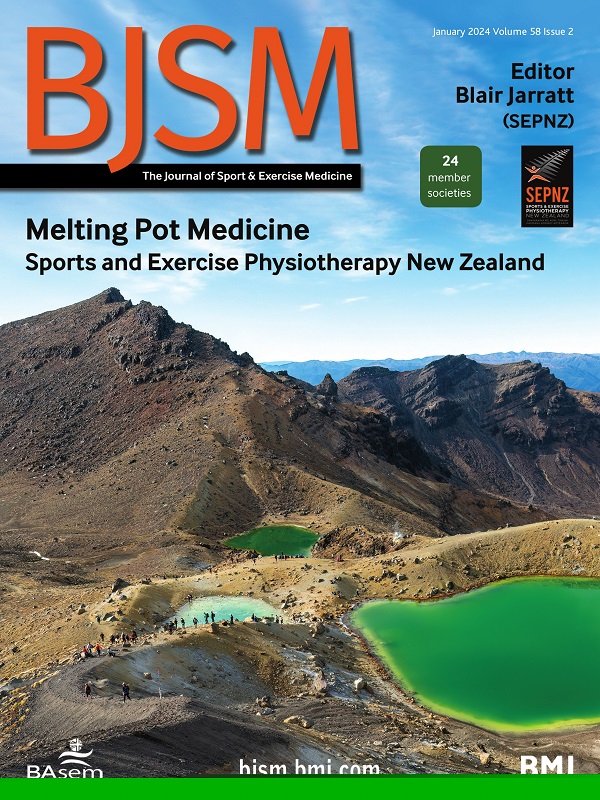Determination of athlete-exposures in team sports: it depends on the research question
IF 11.6
1区 医学
Q1 SPORT SCIENCES
引用次数: 0
Abstract
We would like to introduce you to Sarah, a sports medicine clinician who cares for team sports and is interested in decreasing injury rates. Sarah recognises that to decrease injury rates, she must properly define the term and then use the best methods for assessment. Epidemiology includes definitions for measures such as incidence rates,1 and Knowles et al applied these principles to sports injuries in 2006.2 Injury rates depend on a proper numerator, that is, the injuries, and a proper denominator, that is, exposure time. Our focus is on the denominator, exposure time, where the assessment should only include ‘athletes-at-risk’.2 In sports, an athlete is generally only at risk for injury while they are on the field, playing their sport. This editorial focuses on team sports where Sarah notices that many injury surveillance studies calculate exposure time in team sports using the phrase, ‘athlete-exposures’, where it is defined as ‘one athlete participating in one game or practice’.3–6 This definition is imprecise and some have interpreted ‘participating’ as only those who played in the games, regardless of the duration,7 and others have interpreted it to include everyone on the game roster, even if they had no playing time.8 Since players on the bench are not at risk for a game-time injury, if there are any substitutions, then both of the above definitions of ‘athlete-exposures’ violate the rule to assess only those at risk. Therefore, for many research questions, these definitions of athlete-exposures overestimate exposure time and consequently underestimate injury rates. This is especially important when comparing across sports as some sports have a large percentage of players on the bench as opposed to in the game, for example, basketball and ice hockey, whereas other sports may have few players on the bench compared with in …团队运动中运动员暴露的测定:取决于研究问题
我们想把你介绍给莎拉,她是一位运动医学临床医生,她关心团队运动,对降低受伤率很感兴趣。萨拉认识到,为了降低受伤率,她必须正确定义这个术语,然后使用最好的评估方法。流行病学包括对发病率等测量的定义,1和Knowles等人在2006年将这些原则应用于运动损伤6.2损伤率取决于适当的分子,即损伤,和适当的分母,即暴露时间。我们的重点是分母,暴露时间,评估应该只包括“运动员的风险”在体育运动中,运动员通常只有在场上进行运动时才有受伤的危险。这篇社论关注的是团队运动,Sarah注意到许多损伤监测研究使用短语“运动员暴露”来计算团队运动中的暴露时间,其中定义为“一名运动员参加一场比赛或练习”。3-6这个定义是不精确的,有些人将“参与”解释为只包括那些参加游戏的人,而不考虑持续时间,而其他人则将其解释为包括游戏名单上的每个人,即使他们没有上场时间由于替补球员在比赛期间没有受伤的风险,如果有任何替换,那么上述两种“运动员暴露”的定义都违反了只评估那些有风险的规则。因此,对于许多研究问题,这些运动员暴露的定义高估了暴露时间,从而低估了受伤率。这在跨运动进行比较时尤其重要,因为有些运动的板凳球员比例比比赛中的高,例如篮球和冰球,而其他运动的板凳球员比例可能比比赛中的少。
本文章由计算机程序翻译,如有差异,请以英文原文为准。
求助全文
约1分钟内获得全文
求助全文
来源期刊
CiteScore
27.10
自引率
4.90%
发文量
217
审稿时长
3-8 weeks
期刊介绍:
The British Journal of Sports Medicine (BJSM) is a dynamic platform that presents groundbreaking research, thought-provoking reviews, and meaningful discussions on sport and exercise medicine. Our focus encompasses various clinically-relevant aspects such as physiotherapy, physical therapy, and rehabilitation. With an aim to foster innovation, education, and knowledge translation, we strive to bridge the gap between research and practical implementation in the field. Our multi-media approach, including web, print, video, and audio resources, along with our active presence on social media, connects a global community of healthcare professionals dedicated to treating active individuals.

 求助内容:
求助内容: 应助结果提醒方式:
应助结果提醒方式:


